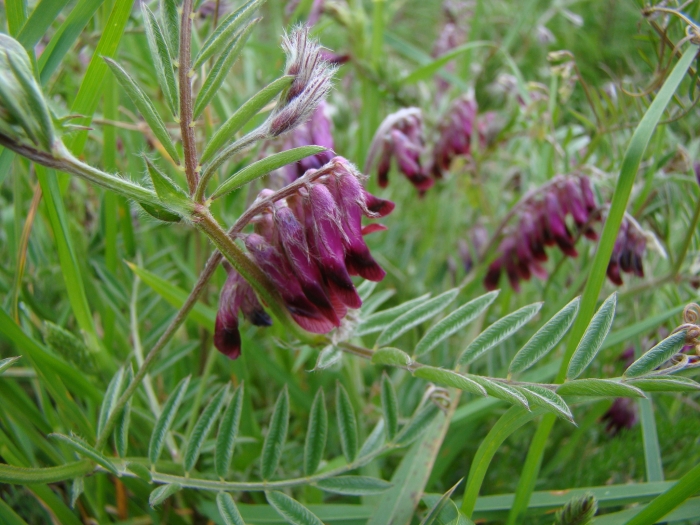Purple Vetch
(Vicia benghalensis)
Purple Vetch (Vicia benghalensis)
/
/

Lisa Bennett
CC BY 4.0
Image By:
Lisa Bennett
Recorded By:
Copyright:
CC BY 4.0
Copyright Notice:
Photo by: Lisa Bennett | License Type: CC BY 4.0 | License URL: http://creativecommons.org/licenses/by/4.0/ | Rights Holder: Lisa Bennett | Publisher: iNaturalist | Date Created: 2015-11-16T12:27:46-08:00 |

















Estimated Native Range
Summary
Vicia benghalensis, commonly known as Purple Vetch or Winter Vetch, is a climbing or trailing annual herb native to the Mediterranean region, including Europe, Western Asia, and Northern Africa. It is typically found in a variety of habitats such as grasslands, open woodlands, and disturbed sites. This species grows at a moderate rate to a height of 1-3 feet (0.3-0.9 meters) and a width of 1-2 feet (0.3-0.6 meters). Its stems are slender and can be either erect or sprawling, with compound leaves that end in tendrils enabling the plant to climb. Purple Vetch produces showy, purple flowers in dense racemes that bloom in the summer, followed by pods containing seeds.
Purple Vetch is valued for its nitrogen-fixing ability, which enriches the soil, making it a beneficial cover crop in agricultural settings. It is also used for erosion control and as forage for livestock. In ornamental gardens, it can be grown as ground cover or allowed to climb on structures. It requires full sun to part shade and thrives in a range of soil types, including clay, loam, or sandy soils, provided they have medium to fast drainage. It is drought-tolerant once established and has medium water needs. While it is not commonly affected by diseases, it can become weedy and potentially invasive outside its native range, so gardeners should consult local regulations before planting.CC BY-SA 4.0
Purple Vetch is valued for its nitrogen-fixing ability, which enriches the soil, making it a beneficial cover crop in agricultural settings. It is also used for erosion control and as forage for livestock. In ornamental gardens, it can be grown as ground cover or allowed to climb on structures. It requires full sun to part shade and thrives in a range of soil types, including clay, loam, or sandy soils, provided they have medium to fast drainage. It is drought-tolerant once established and has medium water needs. While it is not commonly affected by diseases, it can become weedy and potentially invasive outside its native range, so gardeners should consult local regulations before planting.CC BY-SA 4.0
Plant Description
- Plant Type: Herb
- Height: 1-3 feet
- Width: 1-2 feet
- Growth Rate: Moderate
- Flower Color: Purple
- Flowering Season: Summer
- Leaf Retention:
Growth Requirements
- Sun: Full Sun, Part Shade
- Water: Medium
- Drainage: Medium, Fast
Common Uses
Bee Garden, Bird Garden, Butterfly Garden, Low Maintenance
Natural Habitat
Mediterranean region, including grasslands and open woodlands
Other Names
Common Names: Purple Vetch, Bengal Vetch, Reddish Tufted Vetch, Winter Vetch, Greater Vetch
Scientific Names: , Vicia benghalensis, Cracca benghalensis, Vicia atropurpurea var. punicea, Vicia atropurpurea var. sericea, Vicia atropurpurea var. tenella, Vicia lanata,
GBIF Accepted Name: